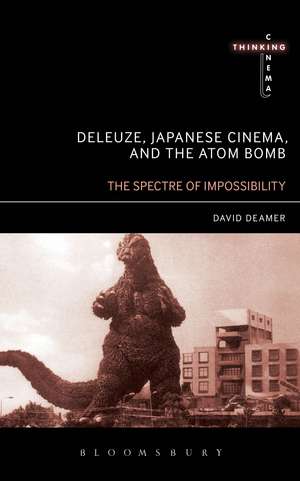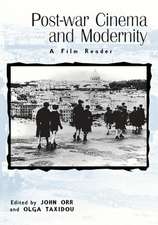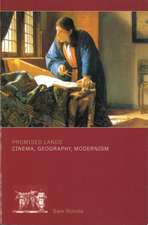Deleuze, Japanese Cinema, and the Atom Bomb: The Spectre of Impossibility: Thinking Cinema
Autor David Deameren Limba Engleză Paperback – 27 ian 2016
| Toate formatele și edițiile | Preț | Express |
|---|---|---|
| Paperback (1) | 259.42 lei 6-8 săpt. | |
| Bloomsbury Publishing – 27 ian 2016 | 259.42 lei 6-8 săpt. | |
| Hardback (1) | 776.24 lei 6-8 săpt. | |
| Bloomsbury Publishing – 24 sep 2014 | 776.24 lei 6-8 săpt. |
Preț: 259.42 lei
Preț vechi: 296.39 lei
-12% Nou
Puncte Express: 389
Preț estimativ în valută:
49.65€ • 50.84$ • 41.30£
49.65€ • 50.84$ • 41.30£
Carte tipărită la comandă
Livrare economică 19 martie-02 aprilie
Preluare comenzi: 021 569.72.76
Specificații
ISBN-13: 9781501317736
ISBN-10: 1501317733
Pagini: 344
Ilustrații: 78 illus
Dimensiuni: 152 x 229 x 25 mm
Greutate: 0.46 kg
Ediția:NIPPOD
Editura: Bloomsbury Publishing
Colecția Bloomsbury Academic
Seria Thinking Cinema
Locul publicării:New York, United States
ISBN-10: 1501317733
Pagini: 344
Ilustrații: 78 illus
Dimensiuni: 152 x 229 x 25 mm
Greutate: 0.46 kg
Ediția:NIPPOD
Editura: Bloomsbury Publishing
Colecția Bloomsbury Academic
Seria Thinking Cinema
Locul publicării:New York, United States
Caracteristici
Enumerates every one of Deleuze's cinema philosophy concepts and explores each through a film
Notă biografică
David Deamer is Associate Lecturer in film at Manchester Metropolitan University, UK. He has published in Martin-Jones and Brown's Deleuze and Film; Bell and Colebrook's Deleuze and History; Deleuze Studies; and the online A/V Journal, of which he was co-founder. He blogs on Deleuze and cinema at www.daviddeamer.com.
Cuprins
List of tablesList of imagesAcknowledgementsIntroduction: event, cinema, cineosis1. Special images, contingent centresMovement-images: Bergson, sensory-motor processThe Effects of the Atomic Bomb on Hiroshima and Nagasaki (Ito Sueo, 1946)Children of the Atom Bomb (Shindo Kaneto, 1952)Godzilla (Honda Ishiro, 1954) 2. Horizons of historyAction-images: Nietzsche, history Terror of Mechagodzilla (Honda Ishiro, 1975)Lucky Dragon No. 5 (Shindo Kaneto, 1959) Barefoot Gen (Masaki Mori, 1983)Nausicaa of the Valley of the Wind (Hayao Miyazaki, 1984)Akira (Katsuhiro Otomo, 1988)3. Traces: symptoms and figuresImpulse-images; reflection-images: Peirce, semiosisThe Naked Island (Shindo Kaneto, 1960)Dead or Alive (Takashi Miike, 1999)Ring (Nakata Hideo, 1998)Kwaidan (Kobayashi Masaki, 1964)The Face of Another (Teshigahara Hiroshi, 1966)Navel and A-bomb (Eikoh Hosoe, 1960)Tetsuo (Shinya Tsukamoto, 1989) Face of Jizo (Kuroki Kazuo, 2004)4. Consummation (and crisis)Mental-images: Bergson, memoryI Live in Fear (Kurosawa Akira, 1955)Rashomon (Kurosawa Akira, 1950)Dreams (Kurosawa Akira, 1990)Rhapsody in August (Kurosawa Akira, 1991)5. Impure anarchic multiplicitiesTime-images: Deleuze, syntheses of timeCasshern (Kiriya Kazuaki, 2004)The Pacific War (Nagisa Oshima, 1968)A History of Postwar Japan as Told by a Bar Hostess (Imamura Shohei, 1970)Black Rain (Imamura Shohei, 1989)Hiroshima (Sekigawa Hideo, 1953)Conclusion: spectres of impossibilityNotesIndexSelect bibliographySelect filmography
Recenzii
This ambitious book brings together three different constellations: the national cinema of Japan; the atom bombs thrown on Hiroshima and Nagasaki; and Deleuze. Surprising though this may sound, the book patiently and expertly weaves these three strands together to the point of making us feel that the Deleuzian cineosis was conceived to address precisely this kind of historico-cinematic encounter. Moving away from reductive ideas of genre, Deamer tackles the complexity of a wide and extremely varied body of films united by the catastrophe of the atom bomb, allowing for a re-evaluation of forgotten gems as well as celebrated masterpieces. Unveiling not one but many Japans, this book testifies to the enduring power and infinite uses of Deleuze's vision of cinema.
Deamer's study is exemplary in its interweaving of film and philosophy. From a philosophical perspective, the book provides a clear, rigorous, and concrete reading of Deleuze's semiotics of cinema and its philosophical grounds. From a cinematic perspective, the book provides a fascinating, detailed study of Japanese cinema, demonstrating the continuing importance of the event of Hiroshima. It provides a thoroughly convincing case for the importance to Japanese cinema of the atom bomb, and the importance to the analysis of cinema more generally of Deleuze's philosophy of film. Highly recommended.
Deleuze, Japanese Cinema, and the Atom Bomb: The Spectre of Impossibility is a well written, clear, insightful and always to-the-point examination of the ways in which Japanese cinema has (and has not) dealt with the atomic bombs ... I congratulate Deamer for both the depth and the breadth with which he approaches this challenging topic ... Deamer writes fluidly, organises his thoughts clearly and displays a profound familiarity with the films that he has chosen as his examples. As a result, the book is a thoroughly pleasant, if demanding, reading experience.
Deamer's study is exemplary in its interweaving of film and philosophy. From a philosophical perspective, the book provides a clear, rigorous, and concrete reading of Deleuze's semiotics of cinema and its philosophical grounds. From a cinematic perspective, the book provides a fascinating, detailed study of Japanese cinema, demonstrating the continuing importance of the event of Hiroshima. It provides a thoroughly convincing case for the importance to Japanese cinema of the atom bomb, and the importance to the analysis of cinema more generally of Deleuze's philosophy of film. Highly recommended.
Deleuze, Japanese Cinema, and the Atom Bomb: The Spectre of Impossibility is a well written, clear, insightful and always to-the-point examination of the ways in which Japanese cinema has (and has not) dealt with the atomic bombs ... I congratulate Deamer for both the depth and the breadth with which he approaches this challenging topic ... Deamer writes fluidly, organises his thoughts clearly and displays a profound familiarity with the films that he has chosen as his examples. As a result, the book is a thoroughly pleasant, if demanding, reading experience.


























